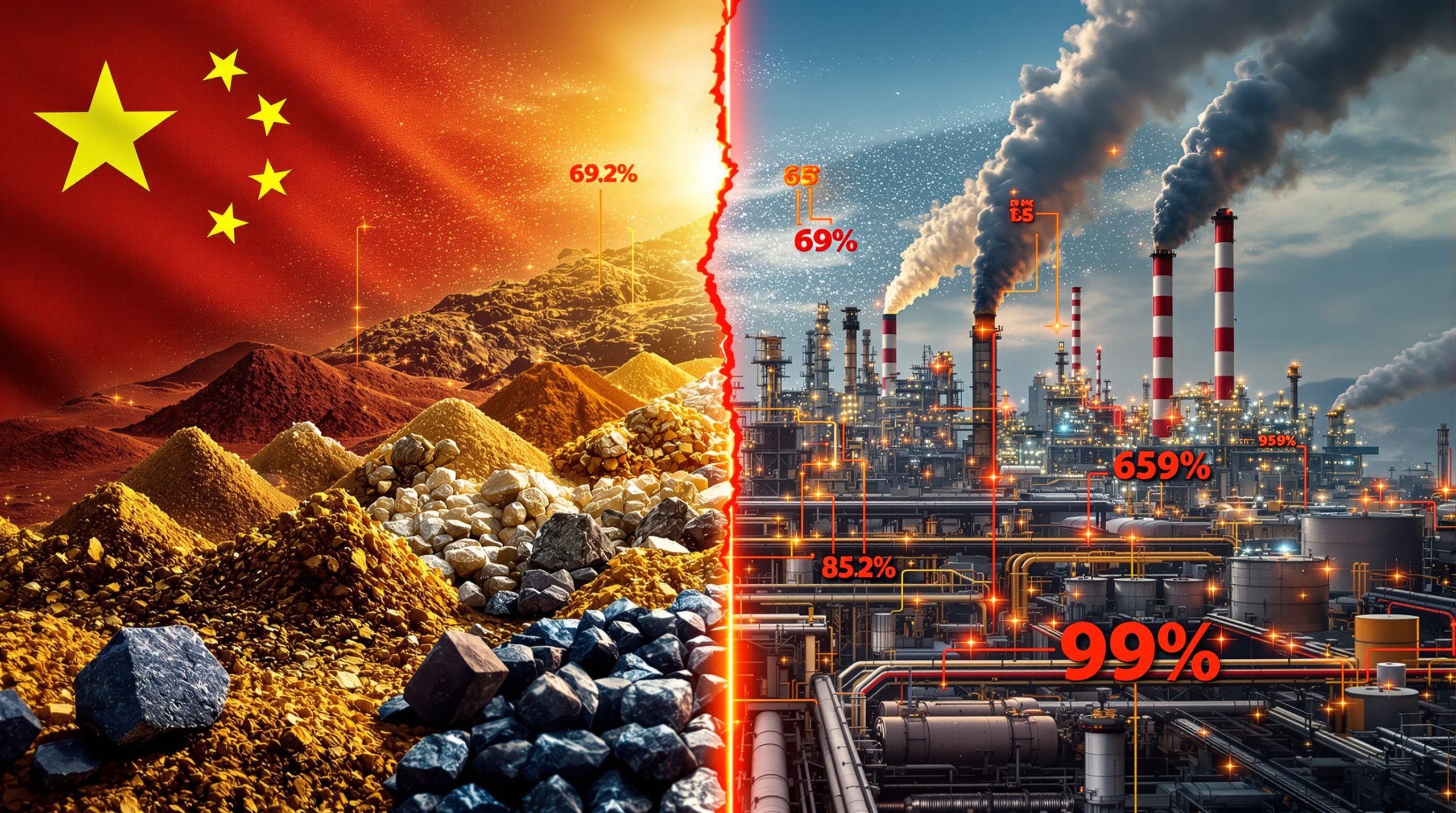What Are Critical Minerals and Why Do They Matter to Australia?
Critical minerals represent more than just valuable resources – they are fundamental building blocks for advanced technologies, clean energy transition, and national security infrastructure. Defined as materials essential for economic and national security, these minerals hold strategic importance due to their limited global supply, concentrated production, and the risk of supply chain disruptions.
Australia occupies a pivotal position in global critical minerals markets, offering a reliable alternative to supply chains historically dominated by China, which controls approximately 80% of global rare earth production. As geopolitical tensions increase and nations seek to diversify their mineral sourcing, Australia's abundant reserves have become increasingly significant on the world stage.
Understanding Critical Minerals in the Global Context
Critical minerals drive innovation across multiple sectors – from batteries and electric vehicles to defense systems and telecommunications infrastructure. The global race to secure stable supplies of these resources has intensified, with countries like the United States, Japan, and European nations actively developing partnerships with reliable suppliers outside China's sphere of influence.
Australia's strategic advantage lies in its political stability, established mining expertise, and commitment to responsible resource development. This positions the country as an increasingly important player in new supply chain configurations that prioritize security and sustainability.
The criticality of these minerals extends beyond their market value. They represent national resilience in a volatile world where resource nationalism is on the rise. For Australia, developing these resources means strengthening both domestic manufacturing capabilities and international alliances.
Australia's Current Critical Minerals Production Landscape
Australia's critical minerals sector already boasts impressive production figures across several key resources:
- Alumina: 19 million tonnes produced in 2023, with Australia holding estimated reserves of 6 billion tonnes
- Bauxite: 102.3Mt of production in 2023-24, supported by massive inferred resources totaling 2.94 billion tonnes
- Zinc: 1.24 million tonnes produced in 2023-24, with 46.27Mt of inferred resources (compared to Canada's 55Mt)
- Uranium: 4,820 tonnes produced in 2022, establishing Australia as the world's fourth-largest producer, with 1,227 ktU in Economic Demonstrated Resources as of December 2021
- Tin: 9 kt produced annually with an inferred resource base of 353 kt
These resources provide the foundation for Australia's growing influence in critical mineral markets. As Warren Pearce, CEO of the Association of Mining and Exploration Companies (AMEC), notes: "This industry provides royalties and tax for Australia's high living standards and generates significant jobs across regional communities."
How Would the Coalition Expand Australia's Critical Minerals List?
The Coalition's proposed expansion of Australia's critical minerals list represents a strategic pivot toward maximizing the country's unique resource advantages. This expansion would incorporate several minerals not currently included on comparable international lists, particularly the United States' critical minerals inventory.
Proposed Additions to the Critical Minerals List
The Coalition strategy would significantly broaden Australia's official critical minerals list to include:
-
Alumina and bauxite: With Australia's estimated reserves of 6 billion tonnes of alumina, these resources provide essential inputs for aluminum production, crucial for everything from aerospace components to renewable energy infrastructure.
-
Zinc: Australia's significant zinc production (1.24 million tonnes in 2023-24) is supported by substantial inferred resources of 46.27Mt. Zinc plays a crucial role in galvanizing steel, manufacturing batteries, and producing brass alloys used in construction, transportation, and electronics.
-
Uranium: With 1,227 ktU in Economic Demonstrated Resources as of December 2021, Australia holds approximately 28% of the world's known recoverable uranium. This resource positions Australia strategically amid renewed global interest in nuclear energy as a low-carbon power source.
-
Potash: Several major projects under development in the Northern Territory and Western Australia demonstrate Australia's potential in this sector. The Lake Giles project alone (operated by Kalium Lakes) contains approximately 1.2 billion tonnes of JORC-compliant resources, providing essential inputs for agricultural fertilizers in a world facing increasing food security challenges.
-
Additional minerals: Phosphate and tin would also gain critical status, recognizing their importance in agricultural production and electronics manufacturing, respectively.
Strategic Differences from International Critical Minerals Lists
The Coalition's proposed critical minerals list diverges strategically from other international frameworks, particularly the United States' list which excludes alumina, zinc, and tin. This reflects Australia's distinctive resource advantages and economic priorities.
As Warren Pearce of AMEC explains: "Including minerals not on the US list aligns with Australia's unique strategic advantages and resource base. This approach recognizes that what's critical for Australian economic security may differ from other nations' priorities."
This divergence has significant implications for international partnerships and trade agreements. By defining its own critical minerals parameters, Australia signals its intention to develop resource policies aligned with national interests rather than simply following allied nations' frameworks.
The expansion also acknowledges the changing dynamics of global mineral markets, where emerging technologies create new demand patterns that may not yet be reflected in established critical mineral shortages elsewhere.
What Economic Incentives Support Critical Minerals Development?
Developing Australia's critical minerals sector requires substantial investment in exploration, extraction, and processing infrastructure. The Coalition's strategy includes significant economic incentives designed to catalyze private sector engagement across the minerals value chain.
Junior Minerals Exploration Incentive (JMEI) Expansion
At the heart of the Coalition's critical minerals development strategy is a $100 million four-year plan to support junior explorers through an expanded Junior Minerals Exploration Incentive (JMEI). This program allows exploration companies to transfer tax credits to their investors, reducing the equity dilution typically associated with early-stage resource development.
The JMEI has demonstrated remarkable success since its inception. Historical data shows it has driven more than $400 million in greenfield mineral exploration – activity that uncovers new resource frontiers rather than expanding existing operations.
The program shows impressive return on investment metrics. For every dollar allocated to JMEI, more than $2 has been spent on direct exploration activities, while $6 has been raised in capital markets. This 6:1 return ratio demonstrates the program's effectiveness in leveraging public funds to stimulate private investment.
To date, the program has involved a total taxpayer investment of $182 million in tax credits, with an application success rate of approximately 78% (2023). Notable success stories include Chalice Mining's Julimar discovery (Nickel-Copper-PGE) which was supported by approximately $15 million in JMEI credits.
AMEC's Warren Pearce has endorsed the program's extension, noting that "JMEI's continuation ensures sector growth and innovation at a time when discovering new global rare earth reserves is essential for Australia's economic future."
The $3.4 Billion 'Resourcing Australia's Prosperity' Program
The broader economic framework supporting critical minerals development includes the $3.4 billion 'Resourcing Australia's Prosperity' program. This initiative has garnered bipartisan support, ensuring program continuity regardless of election outcomes – a crucial factor for investors seeking policy stability.
The program allocates substantial funding for critical minerals processing and manufacturing, recognizing that domestic value addition can significantly increase export earnings. Industry analysts suggest that downstream processing of minerals like lithium can increase their export value by up to 300% compared to shipping raw materials.
These strategic investments aim to strengthen supply chain security while maximizing economic returns from Australia's resource base. By focusing on value-added industries rather than simply extracting and exporting raw materials, the program seeks to create more sophisticated economic opportunities within the minerals sector.
How Would Regulatory Reforms Impact Critical Minerals Projects?
The development of critical minerals projects in Australia has historically been hampered by complex regulatory frameworks that delay project approvals and increase costs. The Coalition's strategy includes significant regulatory reforms designed to accelerate project development without compromising environmental standards.
Streamlining Project Approvals
A cornerstone of the Coalition's critical minerals strategy is its commitment to cut project approval timeframes by 50%. This ambitious target addresses what industry participants describe as "arduous, time consuming, costly, and at times duplicative approvals processes."
Current approval timelines for major resource projects can stretch from 3 to 7 years, as exemplified by delays in projects like BHP's Olympic Dam expansion. These protracted timeframes significantly impact project economics, with industry estimates suggesting delays cost approximately $500 million per year in lost royalties across the sector.
The economic impact of faster project development timelines would be substantial. Accelerated approvals would reduce carrying costs during development phases, improve capital efficiency, and allow projects to capitalize on favorable market conditions more rapidly.
The Western Australia Environmental Protection Authority (EPA) has already demonstrated the potential of streamlined assessment processes for lithium projects, creating a model that could be expanded nationally under the Coalition's reforms.
Industry Response to Proposed Reforms
The proposed regulatory reforms have received strong support from industry bodies. AMEC, representing over 500 member companies across the exploration and mining sectors, has publicly endorsed the approach.
Warren Pearce, AMEC's CEO, articulated the industry position clearly: "Supporting and backing the mining and exploration sector to succeed is both logical and strategically smart. Arduous approvals processes cost time and capital; reforms that maintain environmental standards while reducing bureaucratic inefficiency will unlock significant economic potential."
This industry validation underscores the strategic importance of streamlined regulations in maintaining Australia's competitiveness in global mineral markets. However, the reforms would need to balance expedited approvals with robust environmental safeguards, potentially through mechanisms like Queensland's coexistence framework that protects ecological values while enabling resource development.
What Are the Broader Economic Benefits of Critical Minerals Expansion?
The expansion of Australia's critical minerals sector promises significant economic benefits extending far beyond direct mining revenues. These include employment growth, regional development, and diversification of Australia's economic base.
Employment and Regional Development Opportunities
The job creation potential in exploration, mining, and processing sectors is substantial. The broader mining industry already employs approximately 1.1 million Australians, representing roughly 12% of the national workforce.
Critical minerals development offers particularly rich employment opportunities due to the more labor-intensive nature of some operations compared to bulk commodities. Industry metrics suggest that advanced minerals processing can generate up to four times more jobs per tonne than traditional mining operations – approximately 50 jobs per Mt of alumina compared to 200 jobs per Mt of processed lithium products.
Regional economic diversification represents another significant benefit. Critical minerals projects are often located in regional areas with limited economic alternatives, providing foundational employment and business opportunities. The transformation of regions like the Pilbara from purely iron ore extraction toward more diverse resource development, including hydrogen production linked to mineral processing, demonstrates this potential.
Skills development and training requirements for the future workforce present both challenges and opportunities. The technical complexity of many critical minerals operations requires specialized expertise in metallurgy, chemical processing, and advanced manufacturing – creating pathways for higher-value employment in regional Australia.
Revenue Generation and Economic Contribution
The fiscal contribution of an expanded critical minerals sector would be significant. Royalties and tax contributions to government budgets already form a substantial component of public finance, with Western Australia's mining royalties alone reaching approximately $7 billion in 2024.
Export earnings from critical minerals have the potential to substantially improve Australia's trade balance. As Warren Pearce of AMEC has indicated, value-added processing could triple export earnings compared to shipping raw materials, creating a more sustainable economic model.
Downstream manufacturing and value-adding opportunities represent perhaps the most significant long-term economic benefit. Converting raw materials into higher-value products – such as battery-grade lithium hydroxide rather than raw spodumene concentrate – can increase export values by up to 300%. This vertical integration creates more sophisticated economic structures that are less vulnerable to commodity super cycle impacts.
FAQ: Critical Minerals Development in Australia
What defines a critical mineral in Australia?
Critical minerals in the Australian context are defined by a combination of economic essentiality and supply risk factors. These include materials essential for economic development, defense applications, and emerging technologies where supply chains face potential disruption.
The Australian Strategic Materials Institute applies a structured methodology to assess criticality, considering factors like substitutability, recycling potential, and geopolitical risk alongside economic importance. This produces a more nuanced assessment than simply following international classifications.
The definition also acknowledges minerals with strategic importance in global supply chains, particularly those where Australia has competitive advantages in production or processing. This explains why the Australian list includes minerals not found on comparable international inventories.
How does the Junior Minerals Exploration Incentive (JMEI) work?
The JMEI operates as a tax incentive program allowing eligible exploration companies to pass tax losses to their investors as tax credits. This mechanism effectively subsidizes the high-risk exploration phase of resource development by providing investors with immediate tax benefits rather than requiring them to wait for a project to become profitable.
The application process requires companies to demonstrate their focus on greenfield exploration – discovering entirely new resources rather than expanding known deposits. The program's eligibility requirements prioritize genuine exploration activities that expand Australia's resource base.
The JMEI has demonstrated remarkable ROI metrics, with $2 in exploration expenditure and $6 in capital raised for every $1 of tax credits issued. This leveraging effect makes it among the most efficient government programs supporting the resources sector.
What is the current approval timeline for mining projects in Australia?
Current average timeframes for major mining project approvals in Australia range from 3-7 years, significantly longer than comparable jurisdictions like Canada (2-3 years) or Chile (18-24 months). This extended timeline encompasses multiple approval stages across local, state, and federal authorities.
When compared with international benchmarks, Australia's approval processes appear unnecessarily protracted. While Australia maintains strong environmental standards, countries like Finland demonstrate that rigorous environmental protection can coexist with more efficient regulatory processes.
The economic impact of these delays is substantial – industry analysis suggests each year of delay costs approximately $500 million in foregone royalties across the sector, while also compromising Australia's ability to respond quickly to emerging market opportunities.
How would expanded critical minerals production affect Australia's export markets?
Australia's key trading partners for critical minerals include Japan, South Korea, the European Union, and increasingly the United States – all economies seeking to reduce dependency on China's mineral export controls. Expanded production would strengthen these strategic relationships while potentially opening new markets.
Competition with other major producing nations remains significant. Countries like Canada, Chile, and Brazil are also expanding their critical minerals sectors, creating a competitive landscape that requires Australia to develop distinctive advantages beyond raw materials extraction.
Value-added opportunities beyond raw material exports represent the most promising direction for Australia's export strategy. By developing processing capabilities for materials like rare earth elements, battery minerals, and specialized metals, Australia can capture a larger share of the value chain and develop more resilient trade relationships.
Future Outlook for Australia's Critical Minerals Sector
Strategic Positioning in Global Supply Chains
Australia's potential role as a trusted supplier to allied nations continues to strengthen as concerns about supply chain resilience grow. With projections suggesting Australia could increase its share of global rare earth production to approximately 20% by 2030 (up from less than 10% currently), the country is positioned to become a critical alternative to Chinese dominance.
Competition with other resource-rich countries will intensify as nations like Canada, Brazil, and various African countries develop their own critical minerals strategies. Australia's competitive advantage lies in its established infrastructure, technical expertise, and reputation for political stability and regulatory certainty.
Value-adding opportunities through domestic processing and manufacturing present the most significant growth pathway. The CSIRO's roadmap for hydrogen-integrated mineral processing outlines how Australia could develop energy-efficient processing technologies that leverage the country's renewable energy potential while reducing carbon emissions from traditionally energy-intensive processes.
Technological and Market Trends Driving Demand
The renewable energy transition will continue driving exponential growth in demand for certain critical minerals. International Energy Agency projections suggest a 500% increase in lithium requirements by 2030 to support clean energy technologies.
Electric vehicle and battery production growth remains the most visible demand driver. With major automotive manufacturers committing to electric-only product lines within the decade, the upstream pressure on mineral supply chains will intensify accordingly.
Defense and aerospace applications represent another growth sector, particularly as Western nations seek to rebuild strategic manufacturing capabilities. Advanced materials for hypersonic weapons, military-grade electronics, and space technology all depend on reliable critical mineral inputs.
Digital technology and telecommunications needs will expand as 5G networks, data centers, and advanced computing systems proliferate globally. These applications require specialized materials for semiconductors, optical components, and high-performance cooling systems – all dependent on critical minerals that Australia can supply.
As these technological trends accelerate, Australia's critical minerals strategy will need to evolve from simple extraction toward sophisticated integration with high-technology manufacturing. This evolution, alongside adoption of mining decarbonisation trends, will determine whether Australia remains primarily a supplier of raw materials or becomes a significant player in the high-value segments of global technology supply chains.
Ready to Capitalise on the Next Critical Mineral Discovery?
Stay ahead of the market with instant alerts on significant ASX mineral discoveries through Discovery Alert's proprietary Discovery IQ model, turning complex mineral data into actionable investment insights. Explore why major mineral discoveries can lead to exceptional returns by visiting Discovery Alert's dedicated discoveries page and begin your 30-day free trial today.




